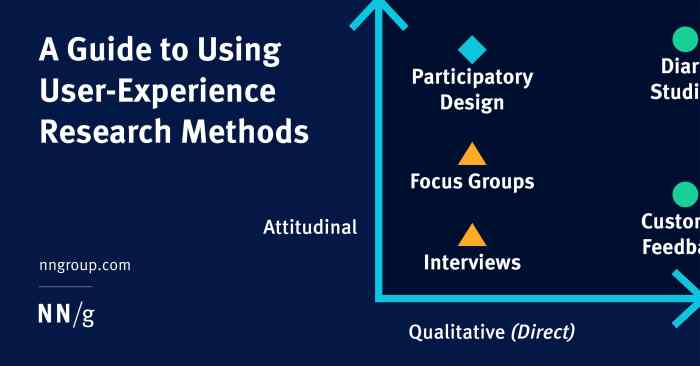Crafting Effective UX Research: A Comprehensive Guide
Embark on a journey through the realm of UX research, where insights and innovation converge to shape exceptional user experiences. This guide offers a detailed exploration of the pivotal role UX research plays in product development and design, providing invaluable strategies and examples to enhance user-centric solutions.
What is UX Research?
UX research, or user experience research, is a crucial process in product development that focuses on understanding user behaviors, needs, and motivations through various research techniques.
Importance of UX Research
UX research is vital in product development as it helps companies create products that meet user needs and expectations, leading to improved user satisfaction and loyalty.
Key Objectives of Conducting UX Research
- Identifying user needs and pain points to improve product design.
- Evaluating user interactions with the product to enhance usability.
- Testing product prototypes to gather feedback for iterative improvements.
Benefits of Incorporating UX Research
- Enhanced user satisfaction and loyalty by delivering products that meet user needs.
- Reduced development costs by identifying and addressing issues early in the design process.
- Increased market competitiveness through user-centric product design.
Methods of UX Research
UX research involves various methods to gather insights into user behaviors and preferences. These methods help designers create products and services that meet user needs effectively.
Interviews
Interviews are a common UX research method where researchers directly interact with users to understand their experiences, preferences, and pain points. This qualitative method provides in-depth insights into user motivations and behaviors.
- One-on-one interviews can be conducted to delve deeper into individual user experiences.
- Focus group interviews can gather feedback from multiple users at once, allowing for group dynamics to influence responses.
Surveys
Surveys are a quantitative research method used to collect data from a large number of users. They help identify trends, preferences, and satisfaction levels among a broad user base.
- Online surveys are cost-effective and efficient for reaching a wide audience.
- Post-interaction surveys can gather feedback immediately after a user interacts with a product or service.
Usability Testing
Usability testing involves observing users as they interact with a product or prototype to identify usability issues. This method provides valuable feedback on the effectiveness and efficiency of a design.
- Remote usability testing can reach a larger pool of participants without geographical constraints.
- In-person usability testing allows researchers to observe user behaviors directly and ask clarifying questions in real-time.
Quantitative vs. Qualitative Research
Quantitative research focuses on gathering numerical data and statistical analysis to measure user behaviors objectively. In contrast, qualitative research aims to understand user motivations, emotions, and perceptions through open-ended responses and observations.
Quantitative research is useful for measuring metrics like task completion rates and error frequencies, while qualitative research provides insights into user preferences, pain points, and motivations.
Each method has its strengths and weaknesses, and the choice depends on the research goals and the type of insights needed to inform design decisions. Combining different methods can provide a comprehensive understanding of user needs and behaviors.
User Personas

User personas are fictional characters created to represent the different types of users who might interact with a product or service. They are based on real data gathered through UX research and help designers understand the needs, behaviors, and goals of their target audience.
Importance of User Personas
User personas play a crucial role in designing user-centric products by providing a clear understanding of the users' preferences and pain points. They help in making informed design decisions that cater to the specific needs of the target audience, ultimately leading to a more user-friendly and successful product.
- Personas guide design choices: By having a persona in mind, designers can tailor the user experience to meet the expectations and requirements of that particular user group.
- Enhanced empathy: User personas humanize the target audience, allowing designers to empathize with their users and create solutions that resonate with them.
- Improved communication: Personas serve as a common reference point for the design team, ensuring that everyone is aligned on who the users are and what they need.
Examples of User Personas Influence in Design
Example 1: A persona named "Sarah," a tech-savvy millennial, influenced the decision to incorporate social media sharing features in a mobile app, catering to her desire for connectivity and sharing.
Example 2: "John," a senior user persona, led to the inclusion of larger font sizes and simplified navigation in a website design, addressing his need for readability and ease of use.
Usability Testing

Usability testing is a crucial step in the UX research process that involves evaluating a product by testing it with real users to identify usability issues and gather feedback on the overall user experience. By observing users interact with the product, designers can uncover areas of improvement to enhance the usability and effectiveness of the design.
Role of Usability Testing in Improving User Experience
Usability testing plays a vital role in improving user experience by providing valuable insights into how users interact with a product. It helps in identifying pain points, confusing elements, or inefficiencies that may hinder the user from achieving their goals effectively.
By addressing these issues through usability testing, designers can create a more intuitive and user-friendly design that meets the needs and expectations of the users.
Identifying Usability Issues and Gathering Feedback
- Usability testing helps in identifying usability issues such as navigation difficulties, unclear instructions, or complex workflows that may impact the user experience negatively.
- By gathering feedback from users during usability testing sessions, designers can understand user preferences, expectations, and behaviors, leading to informed design decisions that prioritize user needs.
- Through direct observation and user feedback, usability testing provides actionable insights that drive iterative improvements in the design to enhance usability and overall user satisfaction.
Examples of Usability Testing Scenarios and Impact on Product Design
- In a usability test for an e-commerce website, users may struggle to find the checkout button, leading to a high abandonment rate. By identifying this issue, designers can optimize the placement and visibility of the checkout button to streamline the purchasing process.
- During a mobile app usability test, users may encounter difficulties in completing a task due to a confusing interface layout. Designers can use this feedback to reorganize the interface, simplify the navigation, and improve the overall user experience.
- In a usability test for a software application, users may express frustration with the lack of clear error messages. By addressing this feedback, designers can enhance error handling mechanisms, provide informative feedback, and create a more user-friendly experience.
Final Review

In conclusion, UX research stands as a cornerstone in creating products that resonate with users on a profound level. By delving into user personas, conducting usability testing, and utilizing diverse research methods, companies can elevate their offerings to meet the evolving needs of their audience.
Embrace the power of UX research to unlock endless possibilities in crafting memorable user experiences.
Essential FAQs
What is the significance of UX research?
UX research plays a crucial role in product development by providing insights into user behaviors and preferences, ultimately guiding the creation of user-friendly designs.
How are user personas created through UX research?
User personas are crafted based on data gathered from UX research, which helps in understanding the needs and characteristics of different user segments.
What is the difference between quantitative and qualitative research in UX?
Quantitative research focuses on numerical data and statistical analysis, while qualitative research delves into the underlying motivations and behaviors of users.
How does usability testing impact product design?
Usability testing identifies potential issues in a product's design, gathers feedback from users, and informs iterative improvements for a better user experience.